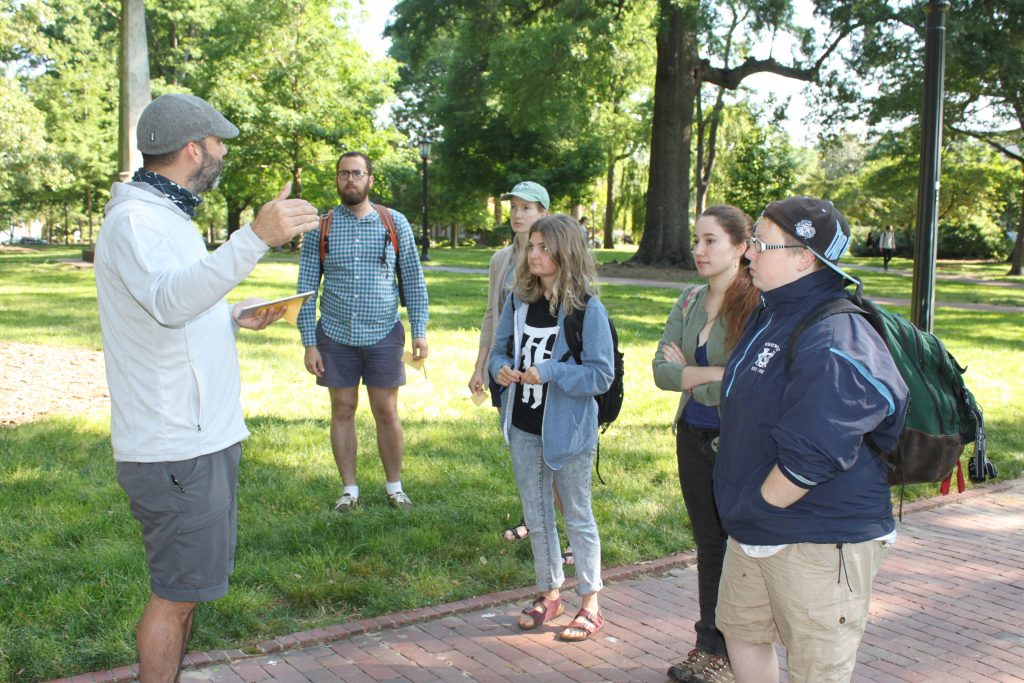
The Arts and Sciences Foundation has formally taken possession of the Franklin Street property that was once the Chapel Hill Public Library, completing a yearlong effort to purchase the mid-century modern structure, which will become the foundation’s new home in late 2016.
The Town of Chapel Hill put 523 E. Franklin St. up for sale in April 2014 through Preservation North Carolina because of the building’s historical significance. The foundation, a nonprofit organization that raises private funds for the College of Arts and Sciences at UNC-Chapel Hill, was the successful bidder, committing last July to paying $1.725 million for the property, which included a payment in lieu of all property taxes. The official close on the property was in June 2015.
The offer was contingent on rezoning the 13,000-square-foot property so that it could be used as office space — a process recently completed by the town.
Built in 1966, the building, at the corner of Franklin and Boundary streets, was the town’s public library until 1994, when the library moved into spacious new quarters on Estes Drive. It then housed the Chapel Hill Museum, which closed in 2010, and the Chapel Hill Historical Society, which has since found a new home in the current library facilities.
“We are excited to be giving this notable landmark a new and vibrant second act,” said Karen Gil, who as dean of the College is also the president of the Arts and Sciences Foundation.
The building was designed by Don Stewart (M.A. regional planning ’59), an area architect highly influenced by Frank Lloyd Wright. Notable buildings Stewart designed in Chapel Hill include Carmichael Arena (known as Carmichael Auditorium when it was built in 1965) and the State Employees Credit Union on Pittsboro Street.
The library is a notable example of mid-century design in the area, said Ellen Weinstein of Weinstein Friedlein Architects, the firm that will renovate the building for the foundation.
“Stewart brought a human scale to it,” said Weinstein. “The way it is sited on the property, the terraces — you enter the building in a very gracious way.”
Preservation North Carolina described the property this way: “The multi-level building is sensitively integrated into its setting, taking advantage of its sloping site. The battered walls, recessed entries with carved redwood doors, and use of native stone, wood shingles stained a light earthen color, and a copper roof display hallmarks of Stewart’s Midwestern organic architectural philosophy. Lewis Clark designed the landscape with its Asian-influenced plantings and patio areas, further evoking the influence of Frank Lloyd Wright.”
The property is under a Historic Preservation Agreement, which protects the exterior from significant alterations. Some interior features, such as the first floor stone fireplace and wood mantle, are protected as well.
Weinstein Friedlein was chosen in part because of the firm’s experience working within historic preservation guidelines, said Rob Parker, executive director of the Arts and Sciences Foundation. He estimated that interior renovations would cost approximately $1.8 million and the building will house up to 38 foundation and College employees. The foundation’s offices are currently at 134 E. Franklin St.
“We think the foundation is a good fit for this historic building and for the surrounding residential neighborhood,” said Parker, noting that many nearby neighbors endorsed the foundation in letters to the Town Council during the bidding process. In addition to its use as office space, the building will be used for meetings of College advisory boards and fundraising committees as well as occasional fundraising events.
Planned renovations include installing an elevator from the first floor to the lower level to make the building ADA-compliant, replacing the original mechanical, electrical and plumbing systems, and installing a new roof. Exterior landscaping will be respectful of the neighborhood’s Historic District status.
“The building has great bones, but it hadn’t been loved in a long time,” said Weinstein.
The foundation is currently seeking bids for contractors with the hope of starting the yearlong renovation process by fall. The building will be paid for with private funds, including a recent $1.25 million gift from an anonymous donor.
By Geneva Collins



